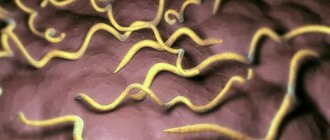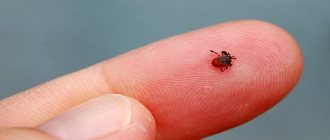Helminth infections affect even the cleanest and most well-groomed dog, so the fight against parasites consists not only of regular washing and protecting it from street acquaintances, but also involves other targeted actions and increased attention from the owner.
How to get rid of worms in a dog, how they can appear and how to recognize them - more on this later in the article.
What to do in such a situation? To get started, we recommend reading this article. This article describes in detail methods of controlling parasites. We also recommend that you consult a specialist. Read the article >>>
Ways of infection with worms
In the vast majority of cases, a dog becomes infected with worms by ingesting their eggs. But there is another way of infection - transmissible, through the bites of blood-sucking insects. In addition, the parasite can enter through lesions on the animal's skin. Newborn puppies easily become infected from their mother, who is a carrier of helminthic infestation.
Helminth eggs can enter the pet’s body if:
- the owner does not pay enough attention to the sanitary and hygienic side of the life of his four-legged friend;
- the dog is not given preventive deworming;
- the pet eats raw meat and fish;
- the dog often walks unaccompanied (dubious “acquaintances” are possible, drinking from puddles, eating various leftovers, and so on);
- There are other animals living in the apartment that have worms.
Under other favorable conditions, a pet can become infected even at home by sniffing the shoes of an owner who comes in from the street.
Note: no dog is immune from worms, but the risk group includes animals with weakened immune systems, puppies, hunting and yard dogs.
Contraindications for worming
Anti-worm medications are toxic, and their uncontrolled use can cause deterioration in the animal’s health. Deworming has a number of contraindications that must be taken into account. Deworming is contraindicated:
- sick, weak and exhausted animals;
- dogs after surgery;
- puppies up to 2 weeks;
- if the animal has external parasites: fleas, lice, ticks.
Read Treatment of allergies in a French bulldog: selection of dry food
Antihelmintics should be given with caution:
- pregnant and lactating dogs;
- animals with chronic diseases;
- animals prone to allergies.
Why are helminths dangerous for dogs?
If left untreated, worms in dogs can lead to serious consequences over time, including:
- weakened immunity and retarded growth and development due to insufficient supply of nutrients to the animal’s body;
- mental exhaustion of the dog due to constant itching, pain, discomfort;
- the addition of infection against the background of a decrease in protective forces, the development of numerous diseases;
- serious intoxication of the pet’s body with toxic metabolic products of parasites, the development of allergic reactions.
Helminths lead to diseases of the liver, brain, heart, lungs and other organs. Ignoring the symptoms of worms in a dog is fraught with the development of jaundice, heart attack, epilepsy, intestinal obstruction, cerebral hemorrhage, loss of vision and other consequences, including death.
Important: according to statistics, more than 60% of domestic dogs are infested with helminths. At the same time, infected pets look clinically healthy, so owners do not always suspect that their beloved animal is sick.
Prevention and treatment of helminthiases
There are a large number of different drugs on the veterinary market that can safely and effectively rid a dog of helminths. They are available in the form of suspensions, tablets, drops on the withers (as a rule, they are also effective against fleas and ticks).
Deworming should be carried out quarterly (once every 3 months), especially if the dog actively walks, picks up from the ground or eats raw foods.
Dogs that do not walk and eat commercial food can be treated once every 6 months.
It is very important to deworm bitches before breeding.
If helminths are detected in a dog, it is necessary to carry out 2 or 3 times treatment with an interval of 10 days - 2 weeks, since the drug only affects adults. The helminth eggs remain intact. Thus, when new helminths hatch from them after 2 weeks, the drug will rid the dog of new parasites.
Puppies are dewormed for the first time at 3 weeks, then again after 10 days. It is very important to deworm before the first vaccination because the puppy must be completely healthy to create a good immune response to the vaccine.
Methods of infection
The danger of the disease lies in the fact that parasite eggs are everywhere: in the water, in the ground, on the grass, in the sand. They get there along with animal excrement. Worm larvae mature at a temperature of 12-13°C and are not at all afraid of frost. Not a single dog, even the most well-groomed one, is completely immune from the threat of infection - this can happen to every pet.
Main methods of infection:
- Street dirt. A dog can pick up worms by drinking from a puddle or pond, licking street dirt from its fur, or picking up something on the street. At home, animals become infected with helminths through the owner's dirty shoes.
- In the womb or while breastfeeding. Puppies of dogs infected with heartworms can become infected directly in the womb or while breastfeeding. This is why it is so important to deworm pregnant animals.
- Parasitic insects. Fleas are carriers of flatworm eggs.
Types of tapeworms in cats and dogs
Tapeworms, or cestodes, are only one of three main classes of helminths (in addition to them, there are also roundworms - nematodes and flukes - trematodes).
Tapeworms in cats and dogs are represented mainly by tapeworms (cucumber tapeworm, etc.), as well as broad tapeworm.
In the photo you can see what tapeworms look like, parasitizing mainly in the small intestine of animals, attaching to its walls with the help of a scolex - a head with suckers and/or special chitinous hooks.
Tapeworms do have a flat body ranging from 15 to 70 cm in length, but it is not uniform, like that of roundworms, but is, as it were, composed of many segments.
In each such segment, larvae mature, and as they mature, the parasite discards a segment, which comes out along with the animal’s feces, ruptures, and the eggs enter the external environment.
Types of helminths
Tapeworms (cestodes)
Flat tape parasites develop in the dog's intestines. They attach themselves to the intestinal walls with suction cups and damage its surface. Where the parasitic worm attaches, an ulcer forms. The parasite's offspring grow and develop rapidly. Some long worms can reach 8-9 meters. The dog's gastrointestinal tract becomes clogged with worms - this leads to exhaustion, and a sad outcome is possible.
Most often, infection occurs from fleas, lice, and lice. Parasitic insects ingest tapeworm eggs, which begin to mature inside them. Cestode larvae enter the pet's body along with an accidentally eaten flea. The dog's intestines are an ideal environment for the development and reproduction of the parasite. The danger of the disease is that it can be asymptomatic for several years. All this time the dog is contagious.
Tapeworms (cestodes)
Symptoms of cestode infection:
- Loss of appetite.
- Depressed or excited state.
- Hypovitaminosis of vitamin B12.
- Signs of gastrointestinal dysfunction appear: vomiting, diarrhea, constipation.
- Pernicious anemia.
- Decreased skin elasticity.
- Chronic dermatitis.
- Nervous attacks.
- An excessively bloated abdomen against a background of general exhaustion of the animal.
Roundworms (nematodes)
Roundworms parasitize the tissues and organs of the dog, most often the gastrointestinal tract, cardiovascular system (heartworms) and lungs (lungworms) are susceptible to infection. Nematodes are the most common helminths. Parasites penetrate the brain and heart and can rupture the intestinal walls or clog it completely, causing obstruction. The disease is considered fatal. There are frequent cases of death from intestinal volvulus, necrosis and peritonitis.
Roundworms (nematodes)
Symptoms of nematode infection:
- Alternating constipation and diarrhea. Uncontrollable diarrhea, yellow stool with mucus and blood. Pieces of helminths or whole individuals are found in the feces.
- Vomit. The attacks are uncontrollable - the dog vomits worms.
- Increased appetite, while the dog is exhausted.
- The dog rubs its anus on the floor, continuously reaching for its tail with its teeth.
- Food perversions - the dog eats soil, chews boards.
- Dermatitis and allergic reactions.
- Developmental delays in young animals.
- A swollen belly against the background of general exhaustion of the puppies.
- Sudden severe cough.
Flukes (trematodes)
Trematodes are parasites that are localized in the liver and bile ducts of dogs. Infection of a pet occurs through water, raw fish or seafood. The parasite attaches itself to internal organs with its suction cups. Mature individuals reproduce quickly and reach sizes of 20 cm.
The danger of infection is that due to the activity of worms, the integrity of the bile ducts is disrupted, which complicates the natural outflow of bile and pancreatic secretions. As a result, dogs develop cirrhosis of the liver, jaundice and other inflammatory phenomena. A fatal outcome cannot be ruled out.
Symptoms of trematodosis:
- Depressed state.
- An enlarged liver can be felt by palpation.
- A series of diarrhea and constipation.
- Exhaustion.
- Jaundice.
- Uncontrollable vomiting.
- Labored breathing.
- Increased body temperature.
- Nervous attacks.
With all types of infection in dogs, a blurred clinical picture is observed. Parasites can multiply asymptomatically in the body of a beloved pet for a long time, which is why it is so important to get tested for worms and carry out timely antiparasitic treatment of the animal.
Common types of parasitic flatworms
Note that in everyday veterinary practice, specialists have to deal with a rather limited list of species.
Cucumber tapeworm
It got its name from the shape of the segments, which are very similar to cucumber seeds. They, by the way, are real “travelers”: there have been cases when worm segments crawled tens of meters away from a pile of feces!
The intermediate host is fleas . The likelihood of human infection is low. In the intestines of a dog, an adult can grow up to 1.3 m (but this is rare, more often - no more than one meter).
Echinococci and alveococci
Extremely dangerous parasites (for both animals and humans). Adult cestodes of these species are extremely modest in size, rarely growing to even a centimeter. The danger comes from the larvae: both dogs and humans are both definitive and intermediate hosts for them (this phenomenon is described below). If eggs of these parasites are detected in an animal’s feces, the dog should be immediately isolated from people (especially children and the elderly).
Bull tapeworm
It occurs in dogs whose owners “get hold of” offal to feed their pets from dubious suppliers. Adult cestodes of this species can grow up to several meters (!) in length, which is why the condition of the sick dog is very serious.
But the main danger is that bovine tapeworms, “following the example” of echinococci and alveocci, can use the dog and human body as a “transshipment point.” Accordingly, the recommendation to immediately isolate a sick animal remains valid in this case.
Principles of treatment of worms in dogs
The veterinarian should recommend an anthelmintic drug for the pet based on age. Many modern drugs are universal, low-toxic and well tolerated by animals.
You should purchase medications from veterinary pharmacies or special departments of pet stores. It is better to give puppies and small breed dogs not a tablet, but a suspension, pouring it in with a syringe. There are also drops for the withers, but they are not suitable for puppies, pregnant bitches and weakened animals. Basic principles of treatment:
- It is better to treat adult dogs of medium and large breeds with tablets, since the dosage is easy to calculate.
- The tablet should be given on an empty stomach. The dose is calculated based on body weight. The suspension is poured into the throat using a dispenser syringe. You can feed your pet two hours after taking the medicine.
- Treatment of dogs for worms will be effective if you use modern drugs, they are used once. Repeating is recommended after 2-3 weeks to destroy the grown larvae.
- The dosage of tablets for prevention is calculated by the veterinarian. Medicine against worms is given from three weeks of age, and tablets are given again every six months. It is important to rid your dog of fleas first. Deworming is carried out two weeks before vaccination.
- During the treatment period, the animal may feel unwell because the body is poisoned by toxins from dead parasites. To reduce the negative effect, during and after taking the tablet, give your pet a sorbent (activated carbon) and a hepatoprotective agent.
- If the animal does not show signs of infection and looks good, then it is better to limit itself to preventive measures (give a tablet once every six months).
- All animals living in the same area will need treatment for worms. Owners should also take an anthelmintic tablet.
How often should a dog be wormed?
Even if your pet lives in sterile conditions and you think that he does not have worms, it is still necessary to regularly worm your puppy and adult dog for preventive purposes.
First deworming
Worms can even appear in newborn puppies. They become infected from their mother, for example through the placenta or milk. Therefore, the first treatment is carried out 3-4 weeks after birth. It is important to use special preparations marked “for puppies”.
The second time worming of puppies should be carried out 10 days after the first dose of the drug. This is necessary in order to remove parasite decay products from the body.
Breaks in domestic dogs
Even if an animal does not leave the apartment, this does not mean that it cannot be infected. Insects - flies and cockroaches - can be carriers of parasite eggs. Also, dirt from the street can be brought into the house on shoes and clothes by the owner himself.
The frequency of preventive deworming depends on the age of the animals. It is recommended to deworm dogs under one year of age once every 3 months. In adult animals, preventive treatment is carried out once every six months.
The number of procedures should also depend on nutrition. If an animal eats natural food (raw meat, minced meat, offal and fresh fish), the risk of infection with parasites increases. Therefore, it is recommended to carry out treatment once every 3-4 months.
For preventive purposes, the animal is treated for worms once. But if parasitosis is suspected, the drug is given again 10-14 days after the first procedure. When deworming, the drug acts only on adult parasites. After 1.5-2 weeks, intact worm eggs mature and grow. They are destroyed with the second dose of the drug.
Signs of parasitosis for which repeated deworming is recommended:
- blood, mucus or adult forms of worms in the stool;
- bloating, characteristic rumbling;
- increased appetite accompanied by weight loss;
- diarrhea and vomiting;
- constipation;
- The dog rubs its anus on the floor, reaching for its tail with its teeth.
Important! If an animal is to be vaccinated, it must be dewormed 7-10 days before vaccination.
Read Causes and symptoms of strange breathing in dogs
How to give drugs to street pets
Animals that live or spend a lot of time outdoors are much more likely to become infected with worms. A dog can pick up worms, for example, by picking up something from the ground, drinking water from a puddle, or by contact with other animals. In this case, it is recommended to give the drug against worms 3-4 times a year.
Deworming for pregnant and lactating women
Deworming is contraindicated in pregnant and lactating dogs. This can negatively affect the health of the puppies. This is especially worth considering in the first half of pregnancy, when all systems and organs are formed in puppies, and any negative intervention can lead to the development of pathologies. It can also cause a miscarriage.
Attention! It is better to worry about getting rid of parasites in advance and worm the dog 1.5-2 weeks before mating. But during estrus it is not recommended to do this.
It is not always possible for the owner to rid the pet of worms before mating. What to do in this case? On the one hand, deworming during pregnancy is dangerous, and on the other hand, parasites can also negatively affect the development of the fetus.
The best option is to use a product that is not contraindicated for pregnant and lactating animals. It is recommended to worm a pregnant dog in the second half of its term, and it is best to do this under the supervision of a veterinarian. A nursing dog can be dewormed no earlier than 2-3 weeks after the birth of the puppies.
Deworming drugs
If the worms have already entered the animal’s body and are actively spreading in the intestines, then action must be taken immediately. The veterinarian will help you choose a remedy for worms in dogs. The following positions deserve special attention:
- Drontal. Available in the form of tablets and suspensions. The first are of two types - for puppies and small breed dogs (per 10 kg of weight), for animals weighing more than 35 kg. The tablets are produced in the form of a stone.
- Prazitel. Available form: tablets and suspension. An anthelmintic suitable for fighting worms. The dose is calculated based on the weight of the animal.
- Helminthal. The drug rarely causes adverse reactions. Available form: suspension or droplets on the withers (from parasites living on the fur). The medicine is not prescribed to collies, shelties and bobtails; these breeds do not tolerate it well.
- Droncite. Available form: tablets, solution for injection. The drug is safe for pregnant bitches and non-toxic for puppies.
- Milbemax. The tablets are suitable for treating gastrointestinal parasites and come in two types – for puppies and small breeds and large dogs. Causes side effects in collies and shelties.
What medications are there for worms?
There are many drugs available to deworm a dog. These can be means of complex action or of a specific focus, helping to cope with one type of worms. The doctor selects the medicine based on the dog’s characteristics.
Anthelminthic medications are available in different forms:
- pills;
- suspensions;
- drops on the tongue or on the withers;
- injections.
In most cases, veterinarians recommend the use of tablets. Suspensions are perfect for puppies. Drops on the withers are easy to use; you don’t need to think about how to give your dog medicine.
Injections against worms are given only by veterinarians if the infection is quite serious and the use of other means will give insignificant results.
Injections are used in especially severe cases
The most popular anti-worm medications are:
- "Azipirin." Release form: tablets. Helps cope with flat and round parasites. The advantage is low toxicity for the animal, so in some cases it can be given to pregnant females. For puppies, use is allowed from 4 weeks.
- "Dehinel Plus". The drug helps get rid of round and tape parasites. The medicine can be used only for dogs of large and medium breeds, for pregnant animals from the second half of gestation only with the permission of a doctor. For puppies, such a remedy is allowed only from 7 weeks under the supervision of a veterinarian.
- "Prazitel." However, of the most famous remedies, it has a broad effect against many types of parasites. Suitable for dogs of any size. Produced in the form of tablets and suspensions for puppies. Do not use for pregnant, malnourished animals, as well as puppies under 2 weeks of age.
- Drontal Plus. It does not require special preparation for use; it is allowed to use the medication as a prophylactic agent. Not suitable for small breed puppies or pregnant dogs.
- "Gelmimax". The medicine is available in three dosages depending on the weight and size of the breed. Veterinarians allow the use of the drug for pregnant animals, but no later than 3 weeks before giving birth. It has a pleasant smell, so feeding it to your dog is quite simple.
The drugs differ, so it is not recommended to choose on your own
Kanikvantel, Milbemax, Pirantel and other products are also used for worming. Some people use traditional methods as anthelmintics. However, it is important to know that such methods, at best, will not give the desired effect, and at worst, they will be dangerous for the animal.
Attention! The use of "Dekaris" is possible only after consulting a doctor and determining the permissible dosage.
Traditional medicine recipes
Folk remedies for worms in dogs are justified if it is not possible to purchase medicine or the animal has contraindications for the use of medications. It is important to force your pet to eat “natural medicine”, because it often has a distinct odor. Common folk methods:
- Sagebrush. It instantly drives out parasites. The herb contains essential oils that are harmful to the nervous system, so it is important to follow the dosage. The course of therapy lasts no more than three days. Method: mix 2 g of dry raw material into the food and give it to the dog in the morning.
- Figs Destroys the shells of parasites. Give 1 piece between feedings.
- Garlic. It is destructive to most parasites. Method: chop several cloves and mix with dill. Add the mixture to the food for a month.
- Pumpkin seeds. Contains an amino acid (cucurbitin), which is dangerous for parasites. It paralyzes their muscular system. Pumpkin seeds enrich the animal's body with vitamins and minerals. Mixed with food in crushed form.
- Carrot. Cut into small pieces (raw) and add to food.
Prevention of helminthic infestations
Before the procedure for expelling parasites, the animal is weighed. All medications, including traditional ones, are given according to the size of the dog.
Recommendations for owners:
- The pet is not allowed to go for walks unattended, care is taken to ensure that it does not eat the excrement of other animals, and it is not allowed to drink water from puddles and ponds.
- Fleas should be hunted down periodically, as they are carriers of helminth eggs.
- It is recommended to carry out procedures for treating external and internal parasites simultaneously, but taking all precautions.
- Dogs should not be given raw fish, especially freshwater fish.
All pets are recommended to be dewormed at least 4 times a year.
It is possible to defeat parasites!
Antiparasitic Complex® - Reliable and safe removal of parasites in 21 days!
- The composition includes only natural ingredients;
- Does not cause side effects;
- Absolutely safe;
- Protects the liver, heart, lungs, stomach, skin from parasites;
- Removes waste products of parasites from the body.
- Effectively destroys most types of helminths in 21 days.
There is now a preferential program for free packaging. Read expert opinion.
Interesting to know:
Bibliography
- Centers for Disease Control and Prevention. Brucellosis. Parasites. Link
- Corbel MJ Parasitic diseases // World Health Organization. Link
- Young EJ Best matches for intestinal parasites // Clinical Infectious Diseases. — 1995. Vol. 21. - P. 283-290. Link
- Yushchuk N.D., Vengerov Yu.A. Infectious diseases: textbook. — 2nd edition. - M.: Medicine, 2003. - 544 p.
- Prevalence of parasitic diseases among the population, 2009 / Kokolova L. M., Reshetnikov A. D., Platonov T. A., Verkhovtseva L. A.
- Helminths of domestic carnivores of the Voronezh region, 2011 / Nikulin P. I., Romashov B. V.
An article for patients with a doctor-diagnosed disease. Does not replace a doctor's appointment and cannot be used for self-diagnosis.
The best stories from our readers
Topic: Parasites are to blame for all troubles!
From: Lyudmila S. ( [email protected] )
To: Administration Noparasites.ru
Not long ago my health condition worsened. I began to feel constant fatigue, headaches, laziness and some kind of endless apathy appeared. Problems also appeared with the gastrointestinal tract: bloating, diarrhea, pain and bad breath.
I thought it was because of the hard work and hoped that it would go away on its own. But every day I felt worse. The doctors couldn’t really say anything either. Everything seems to be normal, but I feel like my body is not healthy.
I decided to go to a private clinic. Here I was advised, in addition to general tests, to get tested for parasites. So in one of the tests they found parasites in me. According to doctors, these were worms, which 90% of people have and almost everyone is infected, to a greater or lesser extent.
I was prescribed a course of antiparasitic medications. But it didn’t give me any results. A week later, a friend sent me a link to an article where some parasitologist shared real tips on fighting parasites. This article literally saved my life. I followed all the advice that was there and after a couple of days I felt much better!
Digestion improved, headaches went away and the vital energy that I so lacked appeared. To be sure, I took the tests again and no parasites were found!
Anyone who wants to cleanse their body of parasites, no matter what types of these creatures live in you, read this article, I’m 100% sure it will help you! Go to article>>>
Still have questions? Ask them in our Anonymous group on VK
How to get rid of parasites in a week. The answer is here!
A reliable and effective remedy for combating worms. Removes all parasites in 21 days.
Go to website
Reviews
Read online
Symptoms that 100% indicate parasites! Take the Test.
How to rid your body of life-threatening parasites before it’s too late!
Read more
Website
To get a consultation
The doctor tells how to quickly get rid of parasites for adults and children!
A parasitologist explains what effective methods exist to combat helminths.
More details
Read completely
Comments
Search for cures for parasites
This service is a small help in finding cures for parasites. To start using it, select the type of parasite. If you don’t know what kind of parasite you are infected with, this parasite identification tool will help you by symptoms.
We recommend reading
Toxoplasmosis in dogs: routes of infection, symptoms and treatment
01/29/202102/01/2021ecoliv94
Worm inspector for cats: instructions for use, cost
01/27/202102/02/2021ecoliv94
Products for cats against ticks and worms: list of the best
01/25/202102/3/2021ecoliv94
Dirofen against worms for cats and dogs: instructions for use, price, analogues
01/25/202102/3/2021ecoliv94











